
The sitar is a plucked stringed instrument, originating from the Indian subcontinent, used in Hindustani classical music. The instrument was invented in medieval India, flourished in the 18th century, and arrived at its present form in 19th-century India. Khusrau Khan, an 18th-century figure of the Mughal Empire has been identified by modern scholarship as the inventor of the sitar. According to most historians, he developed the sitar from the setar, an Iranian instrument of Abbasid or Safavid origin. Another view supported by a minority of scholars is that Khusrau Khan developed it from Veena.
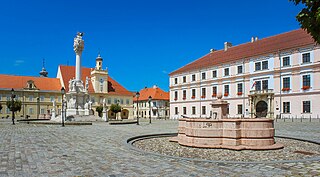
Osijek is the fourth-largest city in Croatia, with a population of 96,848 in 2021. It is the largest city and the economic and cultural centre of the eastern Croatian region of Slavonia, as well as the administrative centre of Osijek-Baranja County. Osijek is on the right bank of the Drava River, 25 km (16 mi) upstream of its confluence with the Danube, at an elevation of 94 m (308 ft).
The music of Croatia, like the divisions of the country itself, has two major influences: Central European, present in central and northern parts of the country including Slavonia, and Mediterranean, present in coastal regions of Dalmatia and Istria.
The gusle or lahuta is a single-stringed musical instrument traditionally used in the Dinarides region of Southeastern Europe. The instrument is always accompanied by singing; musical folklore, specifically epic poetry. The gusle player holds the instrument vertically between his knees, with the left hand fingers on the strings. The strings are never pressed to the neck, giving a harmonic and unique sound.

The tanpura, also referred to as tambura and tanpuri, is a long-necked plucked string instrument, originating in India, found in various forms in Indian music.

"Istrian scale" refers both to a "unique" musical scale and to the folk music genres from Istria and Kvarner which use that scale. It is named for the Istrian peninsula. Istrian folk music is based on a distinctive six-tone musical scale, and the peninsula's two-part, slightly nasal singing. The two-part singing and playing in the Istrian scale, a traditional singing practice characteristic of the Istrian region and the north Adriatic coastal area and islands, was inscribed in UNESCO's List of Intangible Cultural Heritage in 2009.
Tamburica or tamboura, refers to a family of long-necked lutes popular in Southern Europe and Central Europe, especially Serbia, Bosnia and Herzegovina, Croatia, Slovenia, and Hungary. It is also known in Burgenland, Austria. All took their name and some characteristics from the Persian tanbur but also resemble the mandolin and guitar in the sense that its strings are plucked and often paired. The frets may be moveable to allow the playing of various modes. The variety of tamburica shapes known today were developed in Serbia and Croatia by a number of indigenous contributors near the end of the 19th century.

Miroslav Škoro is a Croatian musician, television host and politician. He is the founder and the first president of the conservative Homeland Movement party, which he established in February 2020 and led until July 2021. As a musician, Škoro is best known for using the traditional Slavonian tamburica instrument in most of his compositions.
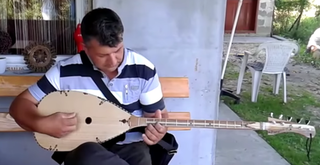
The šargija, anglicized as shargia, is a plucked, fretted long necked lute used in the folk music of various Balkan countries, including Bosnia and Herzegovina, Serbia, Albania, North Macedonia and Kosovo. The instrument is part of a larger family of instruments which includes the Balkan tambura and the bağlama, tamburica, and the tambouras.
Šokci are a South Slavic ethnic group native to historical regions of Baranya, Bačka, Slavonia and Syrmia. These regions today span eastern Croatia, southwestern Hungary, and northern Serbia. They primarily self-identify as a subgroup of Croats and therefore they are not considered a separate ethnicity in Croatia and elsewhere.
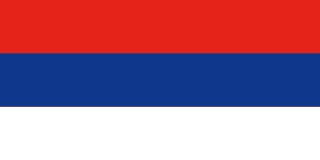
The Serbs of Croatia or Croatian Serbs constitute the largest national minority in Croatia. The community is predominantly Eastern Orthodox Christian by religion, as opposed to the Croats who are Catholic.
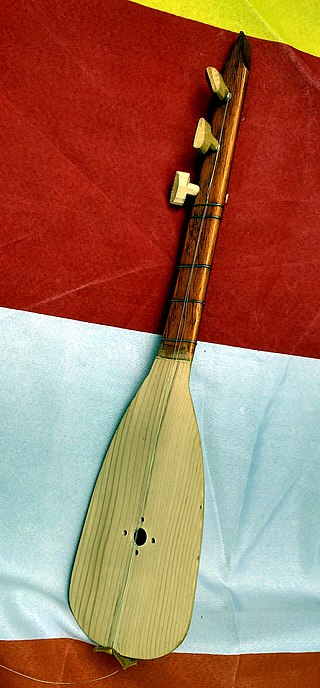
The dangubica or samica is a small Serbian and Croatian stringed instrument, having either two single or two double strings, a long, fretted neck, and a pear-shaped body. One string is used to play the melody, while the second plays a continuous note, known as the drone. Loosely translated, the word danguba means "to lose the day," referring to the instrument's origins among shepherds, who usually played alone as a way to pass the time. This also helps to explain the fact that tuning of the dangubica is widely varied.

Stadion u Kranjčevićevoj ulici, also known as Stadion Concordije between 1921 and 1945, is a multi-purpose stadium located in Trešnjevka neighbourhood, in the Croatian capital of Zagreb. It is mainly used for football matches and was historically the home ground of NK Zagreb until their eviction from the ground in 2018. More recently the stadium has been the home ground for Croatian First League side NK Lokomotiva. In addition, NK Rudeš use the stadium for selected matches, particularly Croatian First League games. First opened in 1921, it has undergone many renovations and facelifts, with its current layout dating back to the 1987 Summer Universiade renovation. The Croatia national football team played only once at the stadium in a 3–0 friendly game win against South Korea on 13 March 1996. With its reduced capacity from 2008, the stadium can hold 8,850 people, which makes it the second biggest stadium in Zagreb, behind Stadion Maksimir. In 2018, the stadium was refurbished with chairs installed in the eastern grandstand and a new hybrid lawn installed, leaving it with a seating capacity of 5,350 seats.
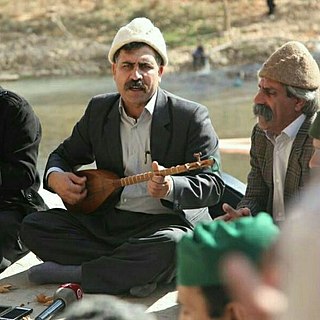
The term Tanbur can refer to various long-necked string instruments originating in Mesopotamia, Southern or Central Asia. According to the New Grove Dictionary of Music and Musicians, "terminology presents a complicated situation. Nowadays the term tanbur is applied to a variety of distinct and related long-necked lutes used in art and folk traditions. Similar or identical instruments are also known by other terms." These instruments are used in the traditional music of Iran, India, Kurdistan, Armenia, Afghanistan, Azerbaijan, Pakistan, Turkey, Tajikistan, Kazakhstan, and Uzbekistan.
Vladimir "Guma" Bogdanović is a Serbian footballer who plays for FC Petrocub Hîncești in the Moldovan National Division.
Bogdan Bogdanović was a Serbian and Yugoslav architect, urbanist and essayist. He taught architecture at the University of Belgrade Faculty of Architecture, where he also served as dean. Bogdanović wrote numerous articles about urbanism, especially about its mythic and symbolic aspects, some of which appeared in international journals such as El País, Die Zeit, and others. He was also involved in politics, as a Yugoslav Partisan in World War II, later as mayor of Belgrade. When Slobodan Milošević rose to power and nationalism gained ground in Yugoslavia, Bogdanović became a dissident.

Croatian is the standardised variety of the Serbo-Croatian pluricentric language mainly used by Croats. It is the national official language and literary standard of Croatia, one of official languages of Bosnia and Herzegovina, Montenegro, the Serbian province of Vojvodina, the European Union and a recognized minority language elsewhere in Serbia and other neighbouring countries.
Statuta Valachorum was a decree issued by Emperor Ferdinand II of the Habsburg monarchy on 5 October 1630 that defined the rights of "Vlachs" in the Military Frontier, in a way that it placed them under direct rule by Vienna, removing the jurisdiction of the Croatian parliament. This was one of three major laws enacted in the early 17th century on the taxation and tenancy rights of the Vlachs, together with the earlier 1608 decree by Emperor Rudolf II and a 1627 decree by Ferdinand.

The tambura is a stringed instrument that is played as a folk instrument in Bosnia and Herzegovina, Bulgaria, Croatia, North Macedonia, Serbia and Turkey. It has doubled steel strings and is played with a plectrum, in the same manner as a mandolin.
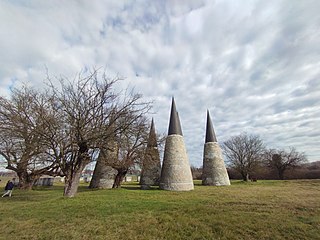
Dudik Memorial Park is a World War II war memorial park located in Vukovar in eastern Croatia. The site is dedicated to 455 individuals who were executed by the authorities of the Independent State of Croatia during the World War II in Yugoslavia.












